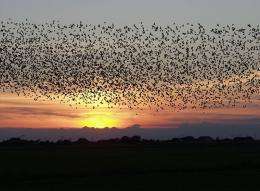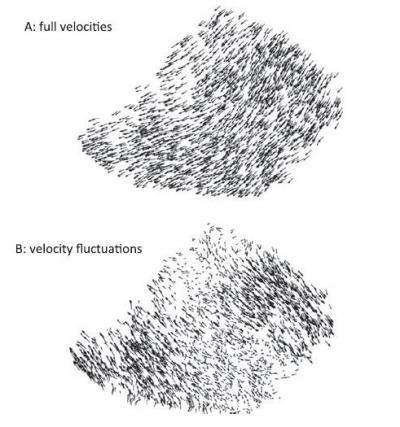June 17, 2010 report
Starling flocks fly like a single entity (w/ Video)

(PhysOrg.com) -- An animal group such as a school of fish or a flock of starlings can seem like a single entity governed by a collective mind. A new mathematical analysis of flight dynamics in flocks of starlings suggest this is because the birds are effectively a single network, with every bird’s movements affected by every other bird’s movements, as if they were all connected together.
The phenomenon adopted by the flock of starlings (Sturnus vulgaris) is called “scale-free behavioral correlation,” which occurs outside of biology in events such as an avalanche or the formation of crystals, both of which are critical systems in which nearly instantaneous transformation can occur.
When a starling flock acts as if it were a single entity it is acting as a critical system and is also optimizing its collective response to challenges such as a predator attack, according to theoretical physicist Giorgio Parisi and colleagues from the University of Rome. who carried out the study.
The researchers studied flocks of starlings over a major winter roosting site in Rome, measuring the 3D positions and velocities of individual birds. The flocks of birds spent their days in the countryside and returned to the city before sunset, performing aerial displays before they settled for the night. The displays appeared like an aerial dance in which the flocks moved and swirled together. The researchers used stereometric digital photogrammetry and computer vision techniques to reconstruct the 3D positions and 3D velocities of the individual birds in the flock from the consecutive shots of the flock, which were taken at 10 frames per second.

The flocks ranged in size from 122 birds to 4,268, but the size of the flock made no difference to the way they moved. In every case if any one bird turned and changed speed, so did every other bird. What was most surprising to the scientists was the near-instantaneous signal processing speed. How the birds achieve this feat is a mystery.
The synchronization of speeds and orientation is found in critical systems. An example cited by the researchers is ferromagnetism, in which particles in a magnet display perfect interconnection at a specific “critical” temperature.
Physicist Irene Giardina, one of the study’s co-authors, said the results suggest starling flocks behave as critical systems “poised to respond maximally to environmental perturbations,” but she said more analysis would be needed to prove this definitively.
The behavior of the flock of starlings is different to the behavior of a group following a leader. Such a group would move in the same direction and would appear strongly ordered, but there would be no passing of information between individuals and so behavioral fluctuations are independent, with changes in direction of an animal other than the leader having little effect on other members of the group. The starlings’ behavior is an example of self-organization, and the collective response to events such as attack by predators gives them a distinct advantage.
The paper is available online from the Proceedings of the National Academy of Sciences (PNAS).
• PhysOrg.com iPhone / iPad Apps
• PhysOrg.com Audio Podcasts / iTunes
• Join PhysOrg.com on Facebook!
• Follow PhysOrg.com on Twitter!
More information: Andrea Cavagna et al., Scale-free correlations in starling flocks, Proceedings of the National Academy of Sciences, Published online before print June 14, 2010, doi:10.1073/pnas.1005766107
© 2010 PhysOrg.com


















